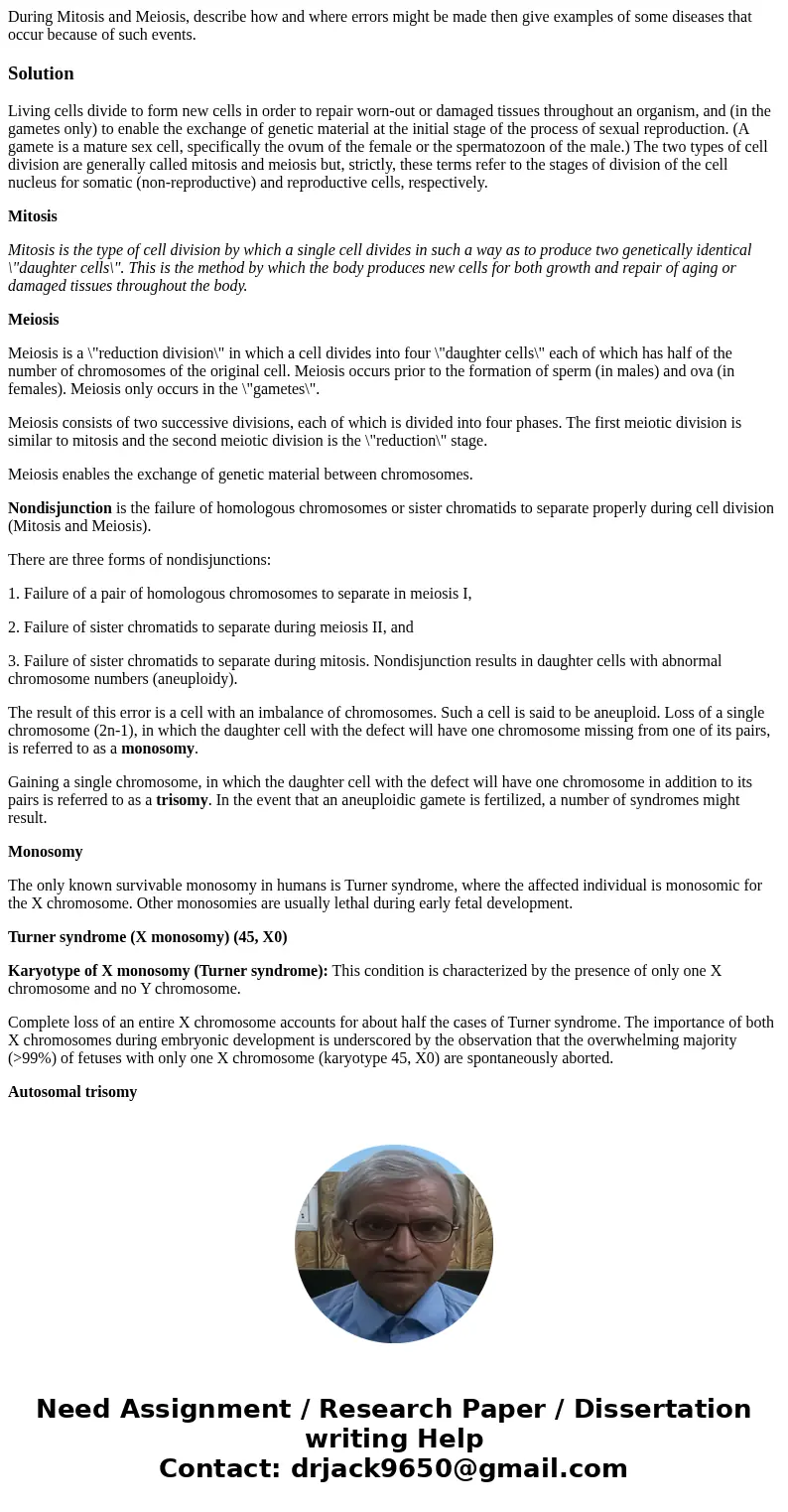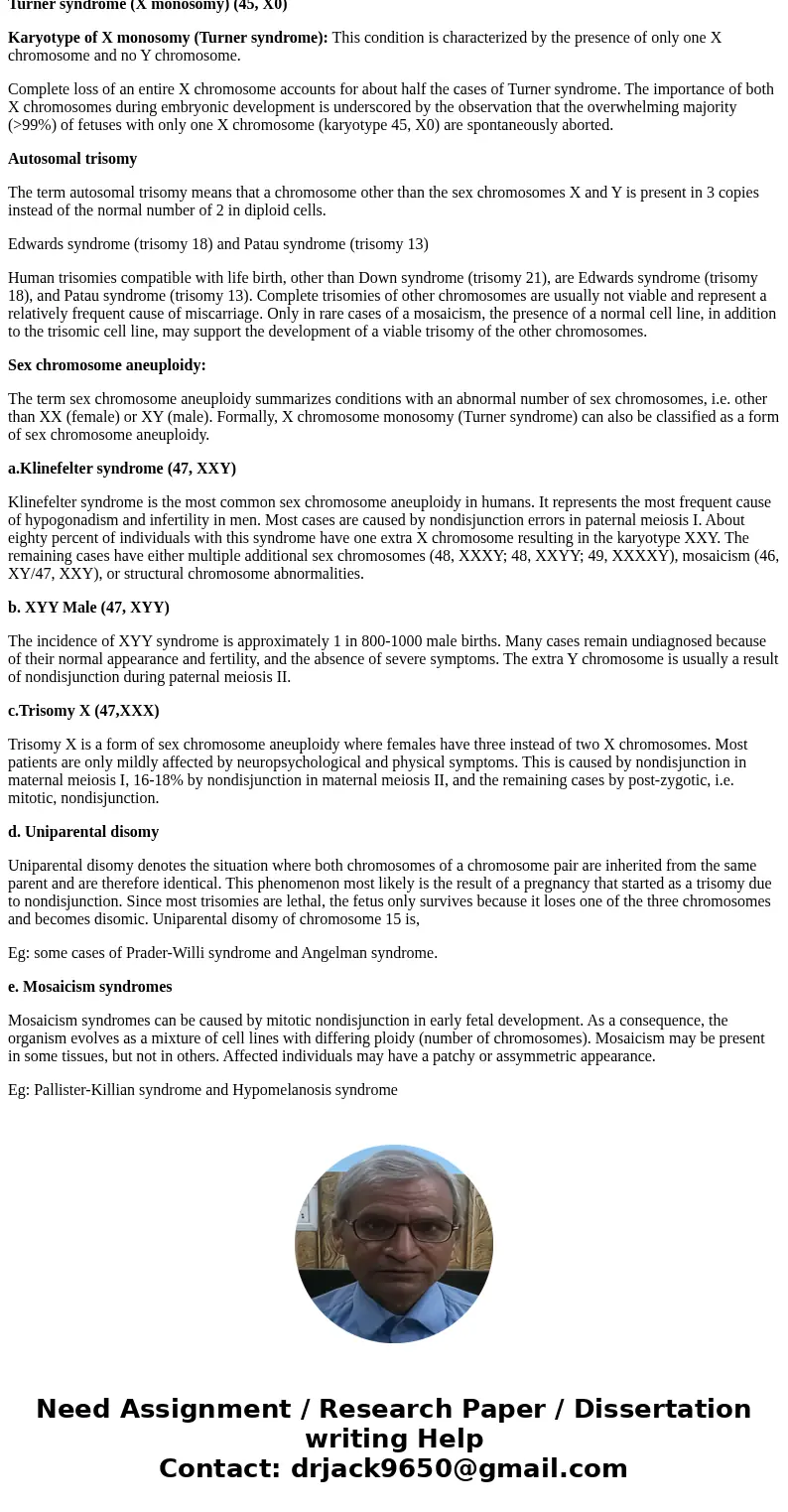During Mitosis and Meiosis describe how and where errors mig
During Mitosis and Meiosis, describe how and where errors might be made then give examples of some diseases that occur because of such events.
Solution
Living cells divide to form new cells in order to repair worn-out or damaged tissues throughout an organism, and (in the gametes only) to enable the exchange of genetic material at the initial stage of the process of sexual reproduction. (A gamete is a mature sex cell, specifically the ovum of the female or the spermatozoon of the male.) The two types of cell division are generally called mitosis and meiosis but, strictly, these terms refer to the stages of division of the cell nucleus for somatic (non-reproductive) and reproductive cells, respectively.
Mitosis
Mitosis is the type of cell division by which a single cell divides in such a way as to produce two genetically identical \"daughter cells\". This is the method by which the body produces new cells for both growth and repair of aging or damaged tissues throughout the body.
Meiosis
Meiosis is a \"reduction division\" in which a cell divides into four \"daughter cells\" each of which has half of the number of chromosomes of the original cell. Meiosis occurs prior to the formation of sperm (in males) and ova (in females). Meiosis only occurs in the \"gametes\".
Meiosis consists of two successive divisions, each of which is divided into four phases. The first meiotic division is similar to mitosis and the second meiotic division is the \"reduction\" stage.
Meiosis enables the exchange of genetic material between chromosomes.
Nondisjunction is the failure of homologous chromosomes or sister chromatids to separate properly during cell division (Mitosis and Meiosis).
There are three forms of nondisjunctions:
1. Failure of a pair of homologous chromosomes to separate in meiosis I,
2. Failure of sister chromatids to separate during meiosis II, and
3. Failure of sister chromatids to separate during mitosis. Nondisjunction results in daughter cells with abnormal chromosome numbers (aneuploidy).
The result of this error is a cell with an imbalance of chromosomes. Such a cell is said to be aneuploid. Loss of a single chromosome (2n-1), in which the daughter cell with the defect will have one chromosome missing from one of its pairs, is referred to as a monosomy.
Gaining a single chromosome, in which the daughter cell with the defect will have one chromosome in addition to its pairs is referred to as a trisomy. In the event that an aneuploidic gamete is fertilized, a number of syndromes might result.
Monosomy
The only known survivable monosomy in humans is Turner syndrome, where the affected individual is monosomic for the X chromosome. Other monosomies are usually lethal during early fetal development.
Turner syndrome (X monosomy) (45, X0)
Karyotype of X monosomy (Turner syndrome): This condition is characterized by the presence of only one X chromosome and no Y chromosome.
Complete loss of an entire X chromosome accounts for about half the cases of Turner syndrome. The importance of both X chromosomes during embryonic development is underscored by the observation that the overwhelming majority (>99%) of fetuses with only one X chromosome (karyotype 45, X0) are spontaneously aborted.
Autosomal trisomy
The term autosomal trisomy means that a chromosome other than the sex chromosomes X and Y is present in 3 copies instead of the normal number of 2 in diploid cells.
Edwards syndrome (trisomy 18) and Patau syndrome (trisomy 13)
Human trisomies compatible with life birth, other than Down syndrome (trisomy 21), are Edwards syndrome (trisomy 18), and Patau syndrome (trisomy 13). Complete trisomies of other chromosomes are usually not viable and represent a relatively frequent cause of miscarriage. Only in rare cases of a mosaicism, the presence of a normal cell line, in addition to the trisomic cell line, may support the development of a viable trisomy of the other chromosomes.
Sex chromosome aneuploidy:
The term sex chromosome aneuploidy summarizes conditions with an abnormal number of sex chromosomes, i.e. other than XX (female) or XY (male). Formally, X chromosome monosomy (Turner syndrome) can also be classified as a form of sex chromosome aneuploidy.
a.Klinefelter syndrome (47, XXY)
Klinefelter syndrome is the most common sex chromosome aneuploidy in humans. It represents the most frequent cause of hypogonadism and infertility in men. Most cases are caused by nondisjunction errors in paternal meiosis I. About eighty percent of individuals with this syndrome have one extra X chromosome resulting in the karyotype XXY. The remaining cases have either multiple additional sex chromosomes (48, XXXY; 48, XXYY; 49, XXXXY), mosaicism (46, XY/47, XXY), or structural chromosome abnormalities.
b. XYY Male (47, XYY)
The incidence of XYY syndrome is approximately 1 in 800-1000 male births. Many cases remain undiagnosed because of their normal appearance and fertility, and the absence of severe symptoms. The extra Y chromosome is usually a result of nondisjunction during paternal meiosis II.
c.Trisomy X (47,XXX)
Trisomy X is a form of sex chromosome aneuploidy where females have three instead of two X chromosomes. Most patients are only mildly affected by neuropsychological and physical symptoms. This is caused by nondisjunction in maternal meiosis I, 16-18% by nondisjunction in maternal meiosis II, and the remaining cases by post-zygotic, i.e. mitotic, nondisjunction.
d. Uniparental disomy
Uniparental disomy denotes the situation where both chromosomes of a chromosome pair are inherited from the same parent and are therefore identical. This phenomenon most likely is the result of a pregnancy that started as a trisomy due to nondisjunction. Since most trisomies are lethal, the fetus only survives because it loses one of the three chromosomes and becomes disomic. Uniparental disomy of chromosome 15 is,
Eg: some cases of Prader-Willi syndrome and Angelman syndrome.
e. Mosaicism syndromes
Mosaicism syndromes can be caused by mitotic nondisjunction in early fetal development. As a consequence, the organism evolves as a mixture of cell lines with differing ploidy (number of chromosomes). Mosaicism may be present in some tissues, but not in others. Affected individuals may have a patchy or assymmetric appearance.
Eg: Pallister-Killian syndrome and Hypomelanosis syndrome


 Homework Sourse
Homework Sourse